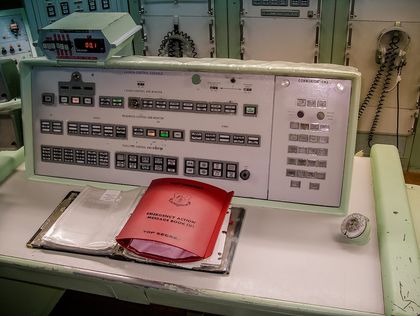Speaker: Apocalypse on the count of three: inside a Soviet missile silo
10 Responses
-
-
Extraordinary ... and chilling! How was he able to take these photos?
-
the sign saying no loan zone is terrfiying
-
Bart Janssen, in reply to
We also visited the Titan missile museum in Tucson Arizona and it really was interesting. Just as strange. The oddest part was how primitive all the equipment looked.
We only lived in Tucson for 7 months but it proved to be a really cool place, The Pima air and space museum which gets examples of just about every weird plane the US has made plus lots from other countries. The massive aircraft storage site where enormous numbers of military aircraft are mothballed. Then there's the desert museum and the desert and mountains themselves. And finally really good stargazing.
-
Bart Janssen, in reply to
How was he able to take these photos?
It's a tourist attraction now.
-
Rich of Observationz, in reply to
I've seen a similar sign on a caged rack in a Wellington data centre.
-
Rich of Observationz, in reply to
how primitive all the equipment looked
Time gets telescoped. It was only 15 years from the V2 to the Titan, which first flew 57 years ago.
-
Matthew Poole, in reply to
the sign saying no loan zone is terrfiying
Not at all unusual. It's just good security practice to not let individuals be in high-sensitivity areas.
-
Rich Lock, in reply to
the sign saying no loan zone is terrfiying
As the old saying about mutually-assured destruction goes: 'never a borrower nor a lender be'.
-
It’s interesting seeing these images (great photography Clinton) having just finished reading the geo-political thriller 2017 : War with Russia. The book is one of the most interesting pieces of bad writing I have come across recently; it makes Tom Clancy look like a Booker Prize winner. The writing is as clunky as hell but the reason so many people are paying attention to it is that the author is General Sir Alexander Richard Shirreff, the recently retired former Deputy Supreme Allied Commander of NATO in Europe. His premise is frighteningly believable; NATO has run down its non-nuclear forces to such an extent that it runs the risk of not being able to respond to a Russian invasion of the Baltic States.
Following the collapse of the Soviet Union, the Ukraine became the third-largest nuclear armed state in the world. In 1994, the signing of the Budapest Memorandum saw an agreement signed between Russia, the USA and the UK (with France and China also having a hand in) that if the Ukraine gave up its nuclear arsenal, their sovereignty and territorial borders would be protected and guaranteed by all. The Ukraine signed up, gave up its nuclear weapons which were disposed of, and 20 years later Russia invaded, annexed Crimea and the world sat back and did f-all.
Shirreff’s concern is that Russia may try this again with the Baltic States and even though they are NATO members, his concern is whether the West would be willing to retaliate when the Baltics have traditionally been seen as being within the Russian sphere of influence. Russia is developing masses of new conventional weaponry, much of which is far more advanced than anything coming out of the West (check out the T-14 Armata tank sometime; it's frightening).
Shirreff's feels that the west probably wouldn't hit the red button in response to a Baltic invasion, running the risk that NATO is seen as no longer being fit-for-purpose and essentially collapses.The 20-page introduction of the book is worth reading for anyone interested in the state of east-west geopolitics should you happen to see a copy in an airport bookshop or similar



Post your response…
This topic is closed.